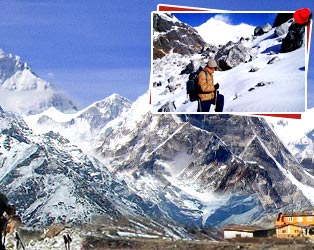Not many places in the world can charm you like the
Himalayas. Not every place gives you the reason to visit there every
season. But then every place does not boast of the beauty as the
Himalayas. The Himalayas are covered with different array of flora and
fauna. With its exotic wildlife and natural beauty it has always
attracted travelers and tourist across the world. The eastern and the
western regions of the Himalayas are covered with varied forests. The
Western region is known for blue pine, spruce, silver fir, junipers,
conifers deodar, and Chirpine, which are found in abundance. While the
eastern Himalayas are famous for maples, rhododendrons, alder, and
birch, oaks, laurels, and dwarf willows. The region of Assam is known
for lush evergreen forests and bamboo and tall grasses. The Himalayas is
the home to many rare species. Nearly about one third of all mountain
animals live here. Due to Himalayas long range, which extends to over
1,500 miles in length and 250 miles in width it is divided into three
ranges: the Lesser, Greater and Outer Himalayas. Since the range is so
much in length and width that variety of climatic condition, vegetation
and wildlife can be seen. The Himalayan regions have many national park
and wildlife sanctuaries. So for people who really want to experience
the flora and fauna of the Himalayas it will be a wonderful experience.
Spring and summer is the best time to visit as the flowers are in full
bloom during this time to welcome the visitors with a burst of colors.
During autumn the chinars take on a special red hue. The Great Himalayan
National Park in the Seraj Forest is a host to variety of birds and
mammals. You can find around 152 species of birds among which 50 are
summer visitors and rests are residents. Various kinds of mammals are
also found in this area. There is another National Park in Arunachal
Pradesh called Namdapha the flora and the fauna facet of this park is
truly amazing. The biodiversity of Namadapha's is very rich. The
Himalayan region is very rich in biodiversity. Himalayas is known for
varied landscape, vegetation and wildlife.
Most of the Himalayan regions have a harsh climatic conditions and
environment it becomes difficult for plants and animals to survive. So
only those animals and plants that can adjust themselves to this
environment can survive. Plants like the tea plant and shrub type plants
and rhododendrons that can adapt to the low temperatures and high winds
can grow. The plants found in this region mostly grow low to the ground
because of the climatic conditions. The National Highway No. 22 is the
route, which passes through the plains to the forested mountain ranges,
along the Sutlej through the gorge in the great Himalayan range near
Shipkila on the Indo-Tibet border. Here the places, which can be
accessed, are the forests on the ridgeline on which lie Shimla, Narkanda
and the amazing forests of silver Fir starting from Narkanda. Nowhere in
the world you will find such variations in the vegetation and wildlife.
From the plains to the snow capped mountains you will witness forests of
Oak, Rhododendron, Birch, Pine, Deodar and Fir.
Mostly common animals are found in the Himalayan Alpine and the
surrounding areas of the Himalayas. Animals that have adapted to the
climatic conditions of the Himalayan regions are mountain goats. They
have special features like thick coat for providing warmth and tough
hooves to run up and down the rocky slopes. In the Outer Himalayan
region the forested lower slopes is the home for animals like
rhinoceroses, bison, and Elephants. While in the foothills animals like
red panda, brown bear, snow leopard, black bear, and languor monkey are
found. Tibetan yak are another animal, which is found in areas above
10,000 ft. The Himalayas is also the home for rare species like Kashmir
stag, musk deer, and rhinoceros. Beautiful varieties of butterflies are
also found. Catfish are quite common in most of the Himalayan streams.
The forest formations here are totally influenced by the rainfall,
height and latitude. As you travel from the east to west the rainfall
decreases. And depending on the rainfall the vegetation grows. So to
capture the very essence of the Himalayas it is important you travel to
those fascinating places as the flora and fauna will definitely amaze
you.



